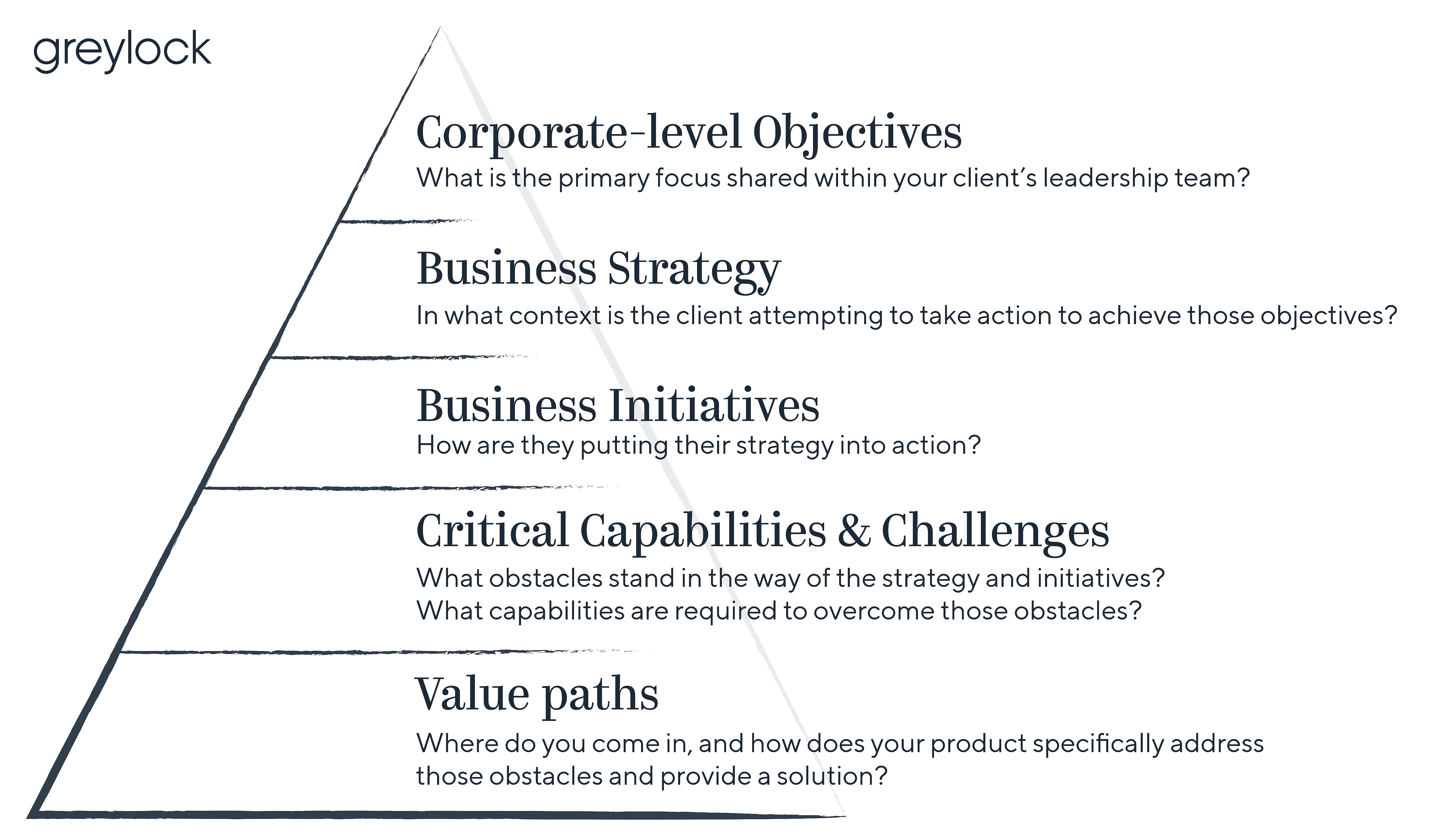
Products don’t sell themselves. Even those that provide inarguable value to a customer can underperform their potential.
Clearly communicated value can lead to faster sales, more accurate pricing, and less customer churn. Value-based sales underpin some of the most successful enterprise software companies and their sustained growth.
Mutual trust between enterprises and sales representatives forms the basis of a successful working relationship, as does a use of straightforward, scalable tools and a clear plan of action. How should sales teams cultivate these practices? And how can leaders foster a value-focused environment while supporting their teams?
Tom Levey, currently the Chief GTM Officer at DataRobot and previously the VP of Sales Strategy and Enablement at AppDynamics, outlined his framework for value-based sales in a private event for sales executives, hosted by Greylock partner David Wadhwani. During the talk, Tom emphasized the importance of effectively translating value, offering key strategies for generating and building lasting relationships.
1. ESTABLISH YOUR PEOPLE, PROCESS, AND EXECUTION
An elite sales team requires three key ingredients, all of which are necessary for success:
- the right people,
- the right process,
- and a maniacal standard of execution.
The right people. The first step is to get the right team in place. Without great talent, the foundation of the sales organization will always be shaky. Yet this doesn’t necessarily mean hiring people with the longest resumes.
The best hires are smart, coachable, hungry, high character people with a strong business acumen and a willingness to learn. Having a structured, disciplined recruiting process and a clear definition of what great looks like is crucial to hiring top talent.
The right process. A high-functioning sales team gives great people great processes. Simple, repeatable processes and tools are effective because they are scalable and underpinned by conscious competence. A rockstar salesperson might use an incredibly effective technique, but a manager should only attempt to replicate that tactic if it’s easy to describe and straightforward to teach. If a process isn’t simple, it’s not scalable.
The right standard of execution. But having great people and great processes aren’t enough. As Tom said, “Even if I had Michael Phelps’ playbook, he would still be faster than me [at swimming].”
And the reason why is because in addition to talent and process, Phelps has a maniacal standard of execution. A culture of execution is the real difference-maker, and breaks out truly elite teams from the merely good ones.
With the right team in place, a simple, repeatable plan/process, and a no excuse culture of excellence in execution, it’s time to start thinking about the customer.
2. TRANSLATE AND ARTICULATE VALUE
Delivering value begins with empathy. The more a sales representative can place him or herself in the shoes of the customer, the more effectively he or she can anticipate what value really means to them.
Working with the customer to simply define the answers to three basic questions, from the point of view of the customer, sets the tone for a trust-based, mutually beneficial relationship:
- Why buy anything?
- Why buy this product?
- Why buy it now?
Tom refers to these questions as “The Three Whys.” As a customer relationship develops, a seller can refine and more accurately answer “why” for each of these questions. Understanding “why” allows sales representatives to translate the challenge into the customer’s language and understanding in order to add value and not simply chase for next steps.
Effectively articulating value depends on a whole-of-business view of the customer, referred to in value-based selling as The Value Pyramid. A customer’s corporate objectives sit at the top of the pyramid, and your product provides the foundation at the bottom, delivering paths to value.
The pyramid is, again, based on empathy — the more a seller can understand the customer’s objectives, the clearer the paths to value will be. When it is, you should be able to clearly articulate, from top to bottom alignment of the Companies corporate-objectives:
- associated business strategies and initiatives,
- associated risks,
- and critical capabilities required to mitigate these risks.

In a sales pitch, it’s easy to talk only about the product.
But as is clear in the Value Pyramid, the customer’s lived experience drives any eventual purchase decision, and a seller should prepare for every customer meeting with this in mind.
3. UTILIZE EXTERNAL STRATEGIES BUILT UPON MEASURABLE INTERNAL STANDARDS OF SUCCESS
Understanding a customer’s needs and effectively communicating solutions with empathy are the primary tools of great sales leaders.
But internal company pressures can distract from freely providing qualitative, nuanced information to customers and building relationships, and sales leaders need to effectively balance delivering quantitative forecasts to senior management.
To avoid frantic guesswork that can arise when sales leaders feel pressured to give sales estimates – without the existence of real data to back it up – disciplined sales leaders make sure to generate other tangible metrics that can be easily demonstrated.
Leading indicators such as the number of business meetings per week, proof of concept plans delivered, or forecasted major deal closings have the double benefit of providing precise numbers while reinforcing effective habits towards relationship development and value delivery.
The number one task in sales is to sell, but great sales leaders find ways to give the CEO the data he or she needs without overly encumbering sales reps with trying to predict the future.
4. GET STARTED EARLY
Startups that build and enforce high standards of value-based sales execution give their product the best chance to succeed. A scaled-up sales organization may look and function quite differently from a founder-led sales effort, but the fundamentals of empathy and delivering value never change.
And the earlier you build great habits, the easier it will be to find the right people, implement great processes, and execute maniacally.
